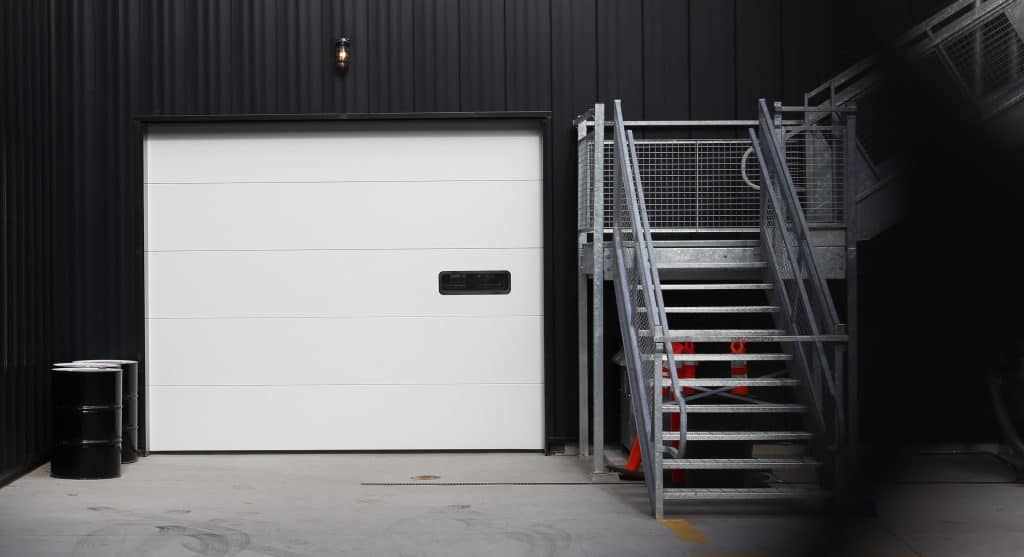Maintenance Schedule for Sectional Doors
Posted Tuesday, March 7th, 2017

Preventative maintenance is a vital step in assuring your commercial doors are safe and last for as long as possible. We recommend following a daily checklist. We also advise having your doors evaluated at least two times per year by a trained and certified technician.
Here are some maintenance specifics for sectional doors.
Recommended Preventative Maintenance Schedule for Sectional Doors
Preventative maintenance on sectional doors varies depending upon the operating conditions of that door. How often it should be maintained depends upon the following:
Environmental conditions
Is the door in a corrosive environment? Is the door located by saltwater? Is the door in a wash down room? Is there a lot of dust getting into the door hardware and on the door?
Usage parameters
Is the door the primary entry and exit into the building? Is the door part of the loading dock area, and exposed to high forklift traffic and potential damage? Is the door the primary entry and exit into the service area and being used for vehicles and pedestrians?
Recommendations
Daily inspections
- Visually look at how the door sits in the opening. Can you see light coming under one side more than the other? Can you see light coming from around the edges of the door?
Look at the door sections. Are they dented, or damaged? Are the sections coming apart? Has the glue or rivets failed leaving the section integrity and strength compromised? Is the metal fatigued and cracking? If the door is insulated, are the back sheets securely fastened to the insulation? - Watch the door as it opens and closes. Is it binding in the tracks?
Operate your door manually. It should roll up and down smoothly. Does it stay in the fully open position or drift down into the opening? Does it fly off the ground and lose momentum at the header? - If the door is chain hoist operated, it should go up smoothly and evenly. Does your door bind on one side of the tracks when you operate the chain hoist? Do you operate the chain without the door moving? The hand chain should fit easily into the chain clasp on the door track or mounted to the wall.
- If the door is motor operated it should fully stop as the door hits the floor and when it fully reaches the header. Does the motor run awhile before the door moves? Does the motor keep running when it hits the floor? Does it stop when it reaches the header or does it stop short or go past?
- If the door is motor operated, check the open, stop close button to make sure all are working. Check the reverse edge on the bottom of the door to make sure the door reverses when it is closing. Check the photo eyes to make sure the door reverses when closing. If a loop is cut into the ground surface, check to make sure it’s opening the door when a vehicle is positioned over it. Check the amount of time it takes to insure proper open or close time after vehicle leaves.
- Look at the vertical track that the door rollers travel in. Are they hit or damaged? Are there missing bolts? Are the wall brackets securely fastened or missing anchors?
- Look up at the horizontal track. Has it been hit or damaged? Is it securely fastened to the back hang angles?
- Is the bottom weather seal intact and making proper contact with the floor?
- Is the side weather seal intact and making contact with the door sections?
- Can you see metal shavings or ball bearings at the base of the vertical tracks?
- Do you hear any clunking sounds from the springs as the door opens and closes?
- The door springs should appear to be continuous from bracket to end. Do you see a gap between two pieces of spring?
- Look at the cables. Are they frayed or twisted?
- Look at the on door hardware. Are all of the fasteners tight? Are there any cracks in the hinges?
- Look at the rollers. Are the roller shafts bent? Do the rollers have excessive play in them?
- Look at the lock. Does it engage the track securely? Does it open smoothly? When it opens, does it clear the track going through the horizontal track?
- If the door has windows, are they cracked? Do each of the windows have all of the glass stop anchoring the glass in?
If you answered yes to any of the above issues, your door should be checked by a trained door technician before using the door further. If any of the safety equipment is not working, your door should be taken out of service until the problem is resolved.
Yearly or semi-annual preventive maintenance is definitely beneficial in catching problems before they turn into emergencies and should only be performed by trained door technicians. Excessive grease and lubrication will actually hamper the door function unless properly applied to where it needs to be.
Warnings:
- Do not continue to operate a door that has been damaged.
- Do not continue to operate a door that is difficult to completely open or close.
- Do not use an electric operator to “power open or close” a poorly operating or damaged door.
- Do not attempt to wind, or unwind, or otherwise tamper with a torsion spring counterbalance system. That includes all brackets, cables, drums, shafts and bearings. Only qualified persons should ever attempt adjustment of the springs or any parts associated with a counterbalance system. Severe injury or death can happen if improperly tampered with.